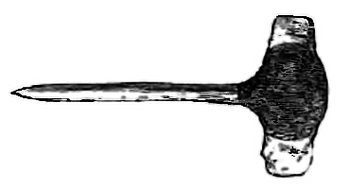The wooden handle is formed of hard wood like that used for spears, namely, Boondono or Mang-art, and is about four-tenths of an inch in diameter and seven inches in length. The handle is fixed to the stone by gum obtained from the tough-top xanthorrhœa, being stronger and more adhesive than that got from the brittle-top xanthorrhœa. It is said that two stones are used in forming the head, and it is not unlikely from the manner in which the handle is inserted that this is so; but the only way in which I could ascertain the mode of construction would be by breaking a tomahawk, and that I should hesitate to do. The Kadjo is usually painted a red color with Wilgee.

|
| FIG. 149. |
The end of the handle is brought to a sharp point, and in climbing trees, the native, after he has cut a hole for his foot, reaches up as high as he can, sticks the sharp end into the bark, and draws himself up with the hold thus obtained.
If the stone forming the head of a West Australian tomahawk were found anywhere divested of the gum and handle, it is doubtful whether it would be recognised by any one as a work of art. It is ruder in its fashioning, owing principally to the material of which it is composed, than even the rude unrubbed chipped cutting-stones of the Tasmanians. There is much to be learnt from the study of a West Australian tomahawk.
The stone-chisel, Fig. 150, is called by the natives Dow-ak or Dun-ah.[1] It is two feet four inches in length, and about one inch in diameter. The cutting edge projects about two-tenths of an inch, and the stone is securely fastened to the head by gum.

|
| FIG. 150.–(Scale 1/10.) |
In two specimens I possess the stone is pure quartz. Below the lump of gum in which the stone is fixed the implement for the length of an inch and a half is smooth; then there is a hollow, and below that the round stick is grooved longitudinally, so as to enable the mechanic to obtain a firm hold of it. The wood is not heavy, but very hard, and of a dark reddish-brown color. It is used for cutting and shaping boomerangs, shields, clubs, &c., and is employed also in war and in hunting. It is thrown in such a manner as to turn over in its flight, and if it strike a man or a kangaroo, death is certain. It closely resembles the stone chisel or gouge used by the natives of the Grey Ranges (lat. 29° 30’ S., long. 141° 30’ E.), but is a neater if not a better tool than theirs.
- ↑ Mr. Philip Chauncy informs me that the stone-chisel is named Dhabba. The Dow-ak is a stick that is thrown, and is rounded at both ends.
